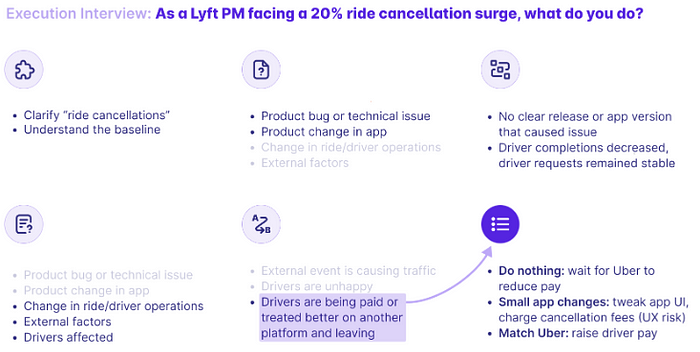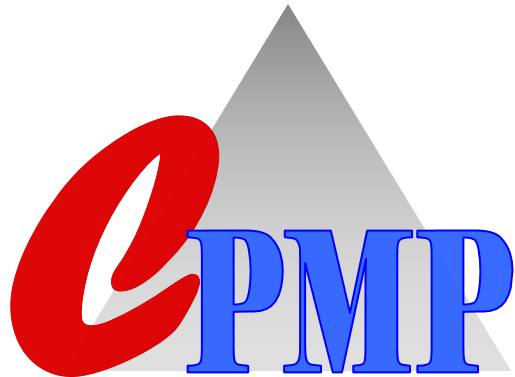
Mastering Execution Interviews: A Guide to PM Success
Introduction to Execution Questions
Execution questions assess your ability to manage the day-to-day responsibilities of a Product Manager (PM). These questions are a specific category of analytical questions aimed at evaluating your skills in problem-solving, data analysis, and logical reasoning. They offer insights into your problem-solving process and your ability to communicate effectively.
Different companies have varied approaches to execution questions, leading to potential confusion. For instance:
Meta focuses on root cause analysis, decision-making, and metrics. Example: “You’re the PM for Facebook Reactions. Reactions are up 20% but comments are down 10%. What would you do?”
Google leans towards broader hypothetical or experiential questions in Craft & Execution and Cross-Functional Collaboration rounds, focusing more on behavioral aspects.
Common Types of Execution Questions
Root Cause Analysis (RCA) Questions
RCA questions often take a “role-play” form, where you need to identify the root cause and recommend next steps. Examples include fluctuations in Facebook Reactions and Lyft ride cancellations.
A framework for approaching RCA questions involves forming hypotheses, gathering data, refining hypotheses, and identifying the root cause.
Decision-making Questions
These questions present a scenario, requiring you to make a decision, sometimes with a yes/no answer or an open-ended approach. Examples include decisions related to Facebook Watch redesign and Uber Eats app strategy.
A specific framework helps in thinking through these questions and providing a well-defended answer.
Metrics Questions
Metrics are crucial for evaluating execution and analytical skills. Examples involve validating new features for Facebook, measuring success for Instagram Shops, and defining success for Yelp reviews.
Craft and Execution
A Google-specific round assessing overall PM skills with questions like design review completion and product goal setting.
Cross-functional Collaboration
Another Google-specific round focusing on behavioral questions related to handling on-the-job scenarios, such as managing requests from major customers or resolving conflicting product requirements.
How to Answer Root Cause Analysis (RCA) Questions in PM Interviews
Root Cause Analysis (RCA) questions are a distinctive type of execution question prevalent in Product Manager (PM) interviews, focusing on identifying the underlying reasons for unexpected occurrences with a product. These questions demand a role-play interviewing style, where the candidate must engage in a dynamic inquiry process, simulating a real-world problem-solving scenario.

Key Components:
- Scenario Presentation: Interviewer presents a problem, e.g., a 20% increase in ride cancellations at Lyft.
- Interactive Role-play: The interviewer acts as a data analyst, pushing the candidate to ask specific, data-driven questions.
- Data-Driven Hypothesis Iteration: Candidates must use the information provided to formulate and refine hypotheses about the root cause.

Structured Framework for RCA:
- Clarify and Gather Context: Ask broad and specific questions to understand the scope and details of the issue.
- Form High-Level Hypotheses: Segment potential root causes into broad categories (technical issues, product changes, operational changes, external events).
- Gather Data: Seek specific data points to validate or invalidate your hypotheses.
- Refine Hypotheses and Repeat: Use new information to narrow down the potential causes.
- Identify the Root Cause: Conclude on the most likely underlying reason for the problem.
- Evaluate: Discuss the implications of the root cause and propose actionable solutions.
How to Answer Decision-Making Questions
Decision-making questions in interviews typically involve scenarios requiring nuanced product decisions, with no clear-cut answers. For instance, you might encounter a question like, “You’re a PM on Facebook Watch working on a redesign that increased watch time but decreased likes and comments. Should you ship this redesign?”
Framework for Answering:
- Clarify and Gather Information: Seek clarity on vague metrics and company or product goals. Questions might include the specifics of the redesign, its impact on watch time, and the magnitude of the drop in likes and comments. Clarifications help define how your decision aligns with overall objectives.
- Set Decision Criteria: Based on the information gathered, establish criteria prioritizing strategic goals, market positioning, user engagement, and revenue implications. This stage is about identifying what’s most important for the product and company, providing a foundation for your decision.
- Generate and Weigh Options: Consider shipping the redesign versus not doing so. Weigh each option against your criteria, considering increased watch time against decreased community interaction. Analyze potential revenue implications and user engagement trends, recognizing the trade-offs involved.
- Decide and Recap: Conclude based on the established criteria. For instance, decide to ship the redesign if increased watch time aligns more closely with strategic priorities, even if it means temporarily sacrificing engagement metrics like likes and comments. Recap your decision process, emphasizing the alignment with strategic goals and potential steps to mitigate negative impacts.
Example Application:
In the context of a Product Manager role at Facebook Watch, let’s explore a practical application of the decision-making framework using a real-world scenario where a redesign has led to increased watch time but decreased user engagement in terms of likes and comments:
- In clarifying, you’d explore the redesign’s specifics and its effects on user behavior and company goals.
- Decision criteria might center on Meta’s mission to connect the world and the strategic importance of video content.
- Weighing options involves comparing the benefits of increased watch time against the costs of reduced community engagement.
- Deciding to ship, you might argue that the redesign’s support for Meta’s long-term vision outweighs the short-term drop in likes and comments, suggesting further investigation into mitigating these impacts.
Rubric for Execution Interviews
Execution Skills
- Isolating Variables: Ranges from failed isolation to admirable with a robust action plan.
- Data Literacy: Ranges from ineffective use of data to extracting valuable insights.
Critical Thinking
- Logical Thinking: Ranges from lack of probing to flawless logic.
- Intuition for Problem-Solving: Ranges from no context consideration to deep systemic understanding.
Culture Fit
- Communication: Ranges from unclear communication to proactive and anticipatory.
- Collaboration: Ranges from lacking initiative to excellent use of interviewer in a collaborative discussion.
